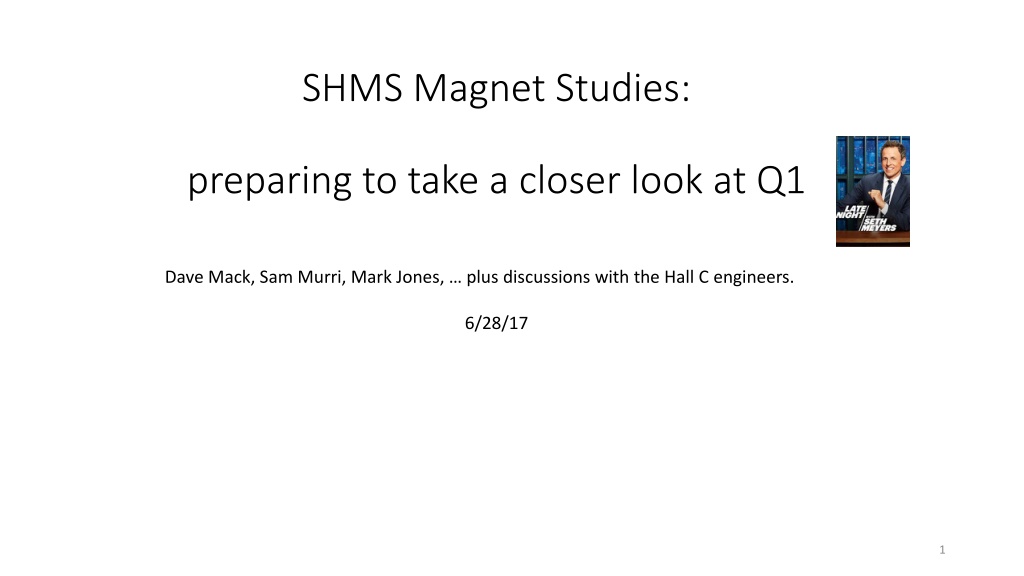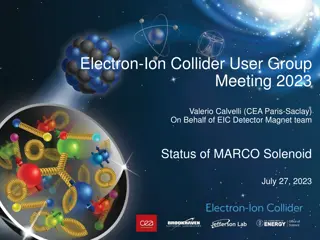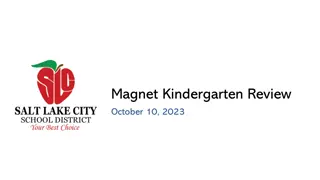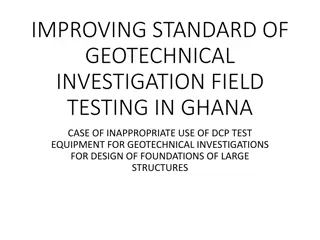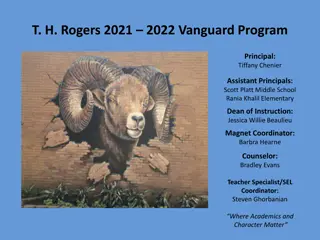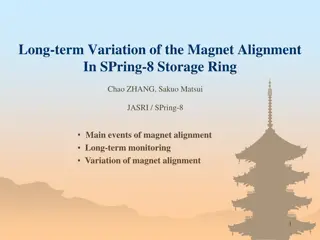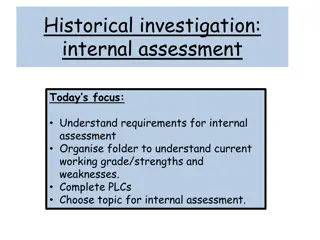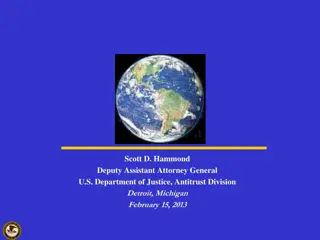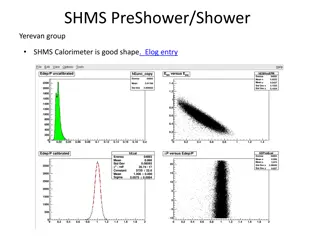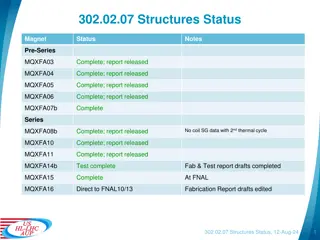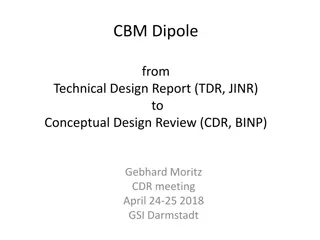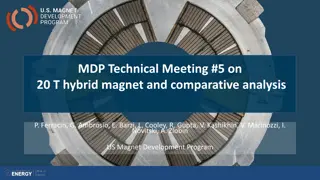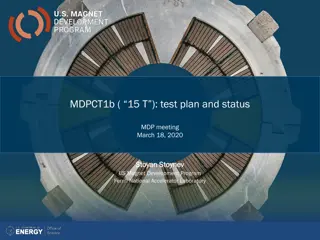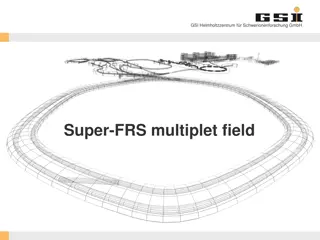SHMS Magnet Studies: Investigation and Challenges
Conducting in-depth studies on the SHMS magnets involving discussions with engineers and analyzing reproducibility requirements for tuning. Focus on Q1 magnet due to its significant field contribution and hysteresis effects. Emphasis on improving accuracy and understanding nonlinearity issues for optimal performance.
Download Presentation

Please find below an Image/Link to download the presentation.
The content on the website is provided AS IS for your information and personal use only. It may not be sold, licensed, or shared on other websites without obtaining consent from the author.If you encounter any issues during the download, it is possible that the publisher has removed the file from their server.
You are allowed to download the files provided on this website for personal or commercial use, subject to the condition that they are used lawfully. All files are the property of their respective owners.
The content on the website is provided AS IS for your information and personal use only. It may not be sold, licensed, or shared on other websites without obtaining consent from the author.
E N D
Presentation Transcript
SHMS Magnet Studies: preparing to take a closer look at Q1 Dave Mack, Sam Murri, Mark Jones, plus discussions with the Hall C engineers. 6/28/17 1
Requirement on SHMS Tune Reproducibility (ie, what is the allowable error for scaling the Golden Tune to arbitrary momenta?) Use specs for an L-T separation as the worst case: Gaskell says Fpi wants +-0.5mrad in angle, +-0.1% in momentum. Momentum measurements are the most precise thing a spectrometer measures, so assume +-0.1% is the tightest requirement on reproducibility. Ignoring the dependence on xpfp for now, P = (dP/dF) F = (dP/dXfp * dXfp/dF) F = (1%/1.65cm * dXfp/dF) F Then solving for F, F = 0.025% * (1.65cm/%) /(dXfp/dF) F (%) SHMS Magnet Maximum Allowable Impact on P dXfp/dFieldIntegral (cm/%) Comments HB 0.025% very small since field is transverse? Even O(1)% might not be a problem??? Impact on also seems small??? Q1 0.025% -0.4cm/% * 0.1% Seems feasible with care. Q2 0.025% +2cm/% * 0.02% OMG! Q3 0.025% -0.4cm/% * 0.1% Easy in principle since it s coil dominated. Dipole 0.025% 1.65cm/% ** 0.025% I just assumed F = P for the dipole. Seems easy with NMR and good cycling. * From slide 8 of Jure s June 23, 2016 talk https://hallcweb.jlab.org/doc-private/ShowDocument?docid=869 ** First order matrix element, Mark Jones personal communication. 2
Why Start with Q1? Q1 and the HB get significant field from iron. Q2, Q3, and the dipole are coil dominated. Hysteresis and saturation effects therefore expected to be larger in Q1 and the HB. The engineers had a lot of time to make measurements on the HB. While enough Q1 measurements were made to constrain multipoles, for > 6 GeV, there are only 4 data points used to fit the 3rdorder polynomial. Residuals between those points might ring unacceptably; we can t tell until we make more measurements. For E < 6 GeV, there are no data. Without more measurements, it won t be possible to set Q1 with sufficient accuracy due to remnant magnetization and possibly other sources of nonlinearity. Problems will grow dramatically below, say, 3 GeV/c. The saturation in Q1 is up to ~3%. To set the tune within spec, we have to correct for this to about 1 part in 30. 3
SHMS Q1 Get documentation on the Hall probe, especially on the offset and the temperature coefficients. (See Extras slide.) Talk to a picky customer for theta and delta reproducibility specs. Estimate the required setting accuracy needed for Q1. Skim existing Q1 data and figure out how we can add value. (We don t want every single momentum setting this Fall to require its own sieve data. ) Get predictions for effective length changes versus current. o Get permission to run Q1 (also Q2 for a short test) and HCList our plans. o 1ST PRODUCT: exercise the Q1 over a large range of current, and determine settling times for required accuracy o Check for possible x-talk between Q1 and HB/Q2 o 2ND PRODUCT: Quantify the reproducibility of the recommended cycling procedure. Also quantify the lack of reproducibility when cycling shortcuts are taken (at least when ignoring small changes in effective length). o Improve constraints on Q1 nonlinearity and saturation by measuring the field over the full range of current (ie, central field is perfectly proportional to central gradient, and central gradient is ALMOST proportional the field integral of the gradient over the length if small changes in Leff are ignored). o 3RD PRODUCT: Develop a function Grad(I_Q3) which goes thru the 4 data gradient points that Mark Jones provided, plus our new data points RENORMALZED by a constant factor. This should model-independently improve Q1 setting performance below 6 GeV. o 3RD PRODUCT v2: To approach a setting accuracy of 0.1% above 6 GeV, we'll have to add a small, model-dependent correction for the reduction in Leff at high fields. 4
Extras 5
Q1/HB Hall probe specs from Sam Murri The probe offset is O(10) = 0.1mV offset*(1000G/~10mV) This offset will be complicate determination of the remnant field. However, we might be able to separate the constant probe offset from the remnant field by assuming the magnitude of the latter is the same for the + and polarities. The tempco of the sensitivity is not bad, but a 2degC change would still nearly exhaust our 0.1% error budget without correction. We should measure the temperature. The tempco of the zero offset ( misalignment ) is negligible. A 2degC change would give a field error of only B = 0.0008mV * 1000G/~10mV = 0.08Gauss. We could in principle cross-check the Q1 setting this Fall by using the Hall probes. But temperature changes and radiation damage will make them unreliable to the accuracy we need. 6
1st Order SHMS Optics from Mark Jones SHMS forward xfp (mm) = -1.38*xtar (mm) - 0.004*xptar (mr) +16.5*delta(%) xpfp (mr) = -.602*xtar (mm) - .72*xptar (mr) - 0.3*delta (%) yfp (mm) = -1.6*ytar (mr) - 0.003*yptar (mr) - 1.5*delta (%) ypfp (mr) = -2.68*ytar (mm) - 0.61*yptar (mr) +0.0074*delta (%) SHMS reconstruction 1st order optics xptar (mr) = 0.26 xfp ( in mm) - 1.38 xpfp ( in mr) delta (%) = 0.06 xfp (in mm) - 0.0012 xpfp ( in mr) ytar (mm) = -.61 yfp (in mm) - 0.04ypfp (in mr) yptar (mr)= 0.27 yfp (in mm) - 1.6 ypfp (in mr) 7
TOSCA effective length change from Steve Lassiter The predicted reduction in Leff is 1%. However, the model predicts saturation more than twice as large as that observed. I need to discuss this with Steve Lassiter, but I suspect this means that the true correction for effective length changes should be only 1% * 3%/8% = 0.4% . We can do most of the saturation correction guided by our Hall probe measurement at a single position. But the correction for Leff changes is going to involve some model- dependent dead-reckoning. 8
SHMS magnet studies 1. Design, build, and install temporary NMR probe in central position in dipole. (See Paul Brindza) 2. Collect documentation on the NMR and the Hall probes. 3. Exercise each of the 5 SHMS magnets over a wide range of momentum settings for both polarities. (This will be faster if all magnets are ramped together.) 4. Determine appropriate settling times for <0.01% changes for each magnet. 5. Check for x-talk by measuring the field in a singly powered magnet, then powering its neighbors. 6. Check and/or establish highly reproducible cycling procedures for each magnet using installed Hall probes (quads) and NMR (dipole). (Dipole: The dipole is normally set by NMR, but a cycling procedure might be useful so that we reproduce the effective length. Plus, if the NMR dies or won t lock at a given momentum, we have a backup plan: use the dipole cycling procedure and set by current. Compare measurements to TOSCA? Quads: The quads will be set by current, initially using TOSCA dead-reckoning, and later Mark Jones s golden values. Given the high gradient and hence position sensitivity, I m not sure comparison to TOSCA makes sense.) Paul Brindza says the Q1 and the HB should show some hysteresis and saturation since a significant part of their field comes from iron. He says that Q2, Q3, and the dipole are coil dominated and should show less hysteresis and saturation. So Q1 and the HB are priorities, but less is known about Q1. So let s start with Q1. 7. Using the above cycling procedure, set the magnets for a wide range of momenta and both polarities. Show that linearity and/or saturation is understood, and that data for both polarities are consistent. 9
